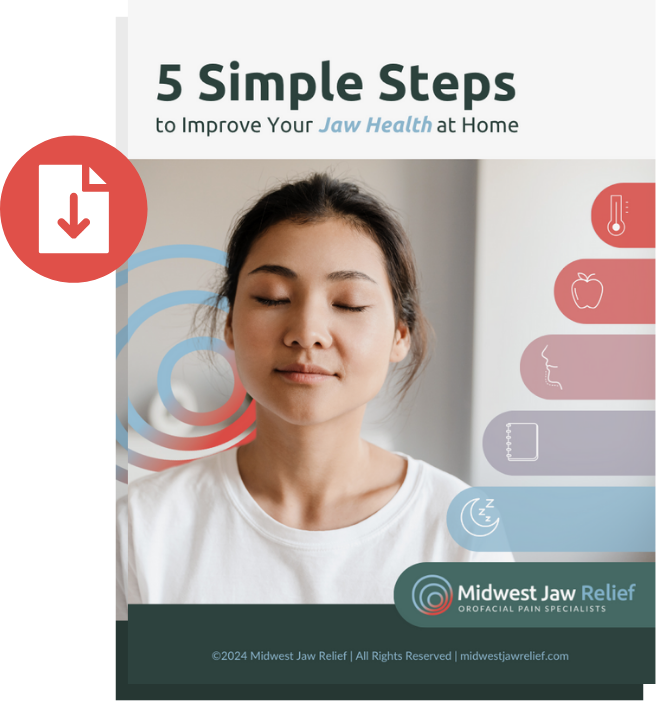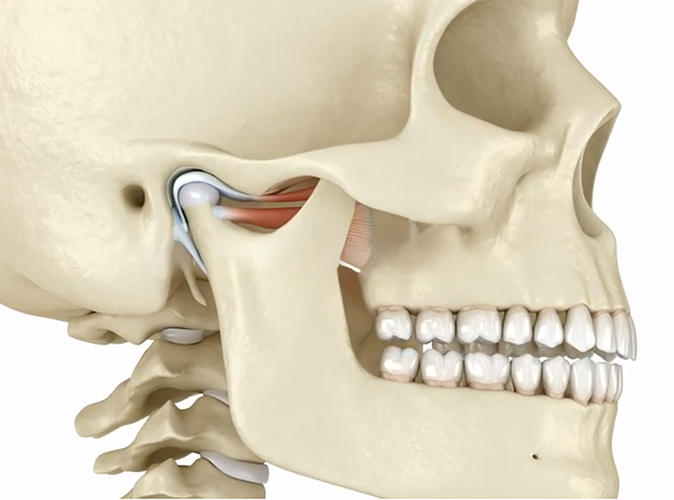TMJ Disorders
Relief from jaw pain and dysfunction.
It's time to enjoy talking, eating and laughing again.
We are here to help bring back your smile.
1 in 3 people report pain or disfunction with their jaw joints or muscles. However, people are often given a “one size fits all” solution that does not address their specific concerns. At Midwest Jaw Relief, we will investigate your unique TMJ symptoms to make sure you have the right diagnosis so you can get the right treatment.
Our goal is to provide relief from your pain and increase your range of motion without expensive braces or invasive surgery.
Make an appointment to receive a customized care plan designed to improve your symptoms, starting from your first visit.
Learn more about how an Orofacial Pain specialist is trained to help with these disorders.
Did you know?
TMJ is short for Temporomandibular Joint
- TMJ is the medical name for your jaw joint. Everyone has two TMJs located on either side of their face that connect their lower jaw to the skull.
TMD is short for Temporomandibular Disorder
- When you have a dysfunction or pain in the jaw, we call that a Temporomandibular Disorder, or TMD for short.
There are over 20 different TMJ Disorders
- Each one is managed and treated differently. If you know you have TMJ issues, make sure you’re seeking a provider who understands the unique differences between these conditions.


TMJ Disorders that we treat:
Jaw Joint Pain and Dysfunction
Joint pain and dysfunction can result from swelling and breakdown of the joint itself, or changes in the position of the disc or tendons that support the smooth movement of the jaw. These changes can be sudden and severe or develop slowly over time. They can feel sharp and may be misdiagnosed as ear pain or a tooth ache. Clicking, popping, or grinding sounds can indicate that the disc has changed shape or position and may result in locking or limited range of motion.
Treatment: Joint pain can often be managed with lifestyle changes, over the counter medications, or a quality stabilization appliance (such as a bite guard). If conservative treatment does not manage your symptoms, steroids, joint injections, or new PRF therapy may be helpful to get you out of pain.
Jaw Muscle Pain
Jaw muscle pain can occur after strain or overuse of the chewing muscles or tendons. It is often felt as a broad band along the side of your jaw or in your temples rather than a specific point. Injured muscles can also send pain to other areas such as the teeth, ears, or eyes. Jaw muscle pain can also occur as part of systemic conditions such as Fibromyalgia.
Treatment: Jaw muscle pain can often be managed with lifestyle changes, medications, or a quality stabilization appliance (such as a bite guard). Trigger point injections can be used to break up dense muscle fibers and kickstart the healing process. Botox injections can also be used to reduce the force and long-term damage that muscle overuse can cause.
Jaw Movement Disorders
Clicking, locking, or other abnormal movements that affect jaw opening and closing can be caused by disc issues, muscles issues or both. Disc and muscle issues can cause the jaw to become stuck open or closed. Conditions like Oromandibular Dystonia can cause uncontrollable movements of the face or jaw.
Treatment: Depending on the exact diagnosis, treatment can range from home-care instruction to injections into the muscles or joints to help them move more smoothly.
“I had lost all range of motion in my jaw and the pain to eat was becoming unbearable. Dr. Guthrie spent so much time with me, helping me find lifestyle habits and a few medications to get me on track.”
FAQs
What types of TMJ Disorders do you treat?
We have experience in the diagnosis and non-surgical management of all TMJ disorders including:
Muscle and Tendon Pain
- Masticatory Myalgia
- Masticatory Myofascial Pain
- Temporal Tendonitis
Joint Pain
- Arthritis
- Arthralgia
- Retrodiscitis
Joint Clicking, Popping and Locking
- Disc Displacement with Reduction
- Disc Displacement without Reduction
- TMJ Adhesion
- TMJ Subluxation
Uncontrollable Mouth Movements
- Oromandibular Dystonia
Pediatric Jaw Joint Disorders
- Idiopathic Condylar Resorption
- Juvinile Idiopathic Arthritis
Headaches Related to Jaw Pain
- Headache Attributed to TMD
- Masticatory Myofascial Pain with Referral
How do you treat TMJ Disorders?
Most TMJ Disorders can be treated with temporary life style adjustments, physical therapy, and if necessary, medications or occlusal appliances to aid in the healing process.
In some cases injection therapy can be helpful:
- Trigger point injections can help break-up “stuck” muscle fibers, allowing them to function better while reduce pain.
- Botox injections can be helpful to reduce the damage caused by years of overused jaw muscles.
- Platelet Rich Fibrin (PRF) injections can help repair and reline your joint surfaces after damage from arthritis.
Do I need crowns, braces, or surgery for my jaw pain?
No, not in most cases. New research suggests that crowns, braces or other treatments that try to permanently alter your bite are unlikely to help treat your jaw pain. Instead, we will use physical therapy techniques, along with medications and a properly adjusted occlusal appliance (when necessary) to help you heal.
A referral to surgery may be required when all other options have failed, but we find that most patients get better with conservative treatment.
What is the best treatment for jaw clicking or popping?
One in three people have a clicking or popping jaw joint. In many cases, clicking or popping can be completely normal and does not mean that your condition will get worse or require treatment. If your clicking is painful or bothersome enough to seek treatment, specific splints or injections may help change or reduce clicking sounds.
Surgical treatment of non-painful clicking joints is almost never recommended, as these types of procedures rarely fix the clicking permanently and can cause significant complications.
Does Botox work for jaw pain?
Yes. Depending on the diagnosis, Botox can be very helpful for managing pain due to overactive muscles.
Once administered, its effects can last up to 3-4 months.
How often do I have to come in to help my jaw pain?
It depends on your diagnosis. Treatment for TMJ Disorders can range from a single visit to more frequent check-ins. Your treatment plan will be tailored to your specific symptoms, with the goal of you being empowered to manage your pain without continuous visits or invasive procedures. If you continue to receive medication, we will often see you on a 6-month basis to monitor your progress.
How do I know what type of TMJ Disorder I have?
The best way to get a definitive diagnosis is to schedule an appointment with a provider who has had advanced training in managing TMJ Disorders, such as a Board Certified Orofacial Pain specialist. With uncommon or complex symptoms, a general dentist may not have the training to diagnose or manage your specific condition.
Jaw relief in three easy steps.
1.
Book a new patient appointment with Dr. Guthrie
2.
Receive a custom treatment plan for your unique symptoms
3.
Eat, laugh and smile again with relief from your jaw pain

Relief sent right to your inbox
Download our 5 Simple Steps to Improve Your Jaw Heath at Home and find relief starting today.


